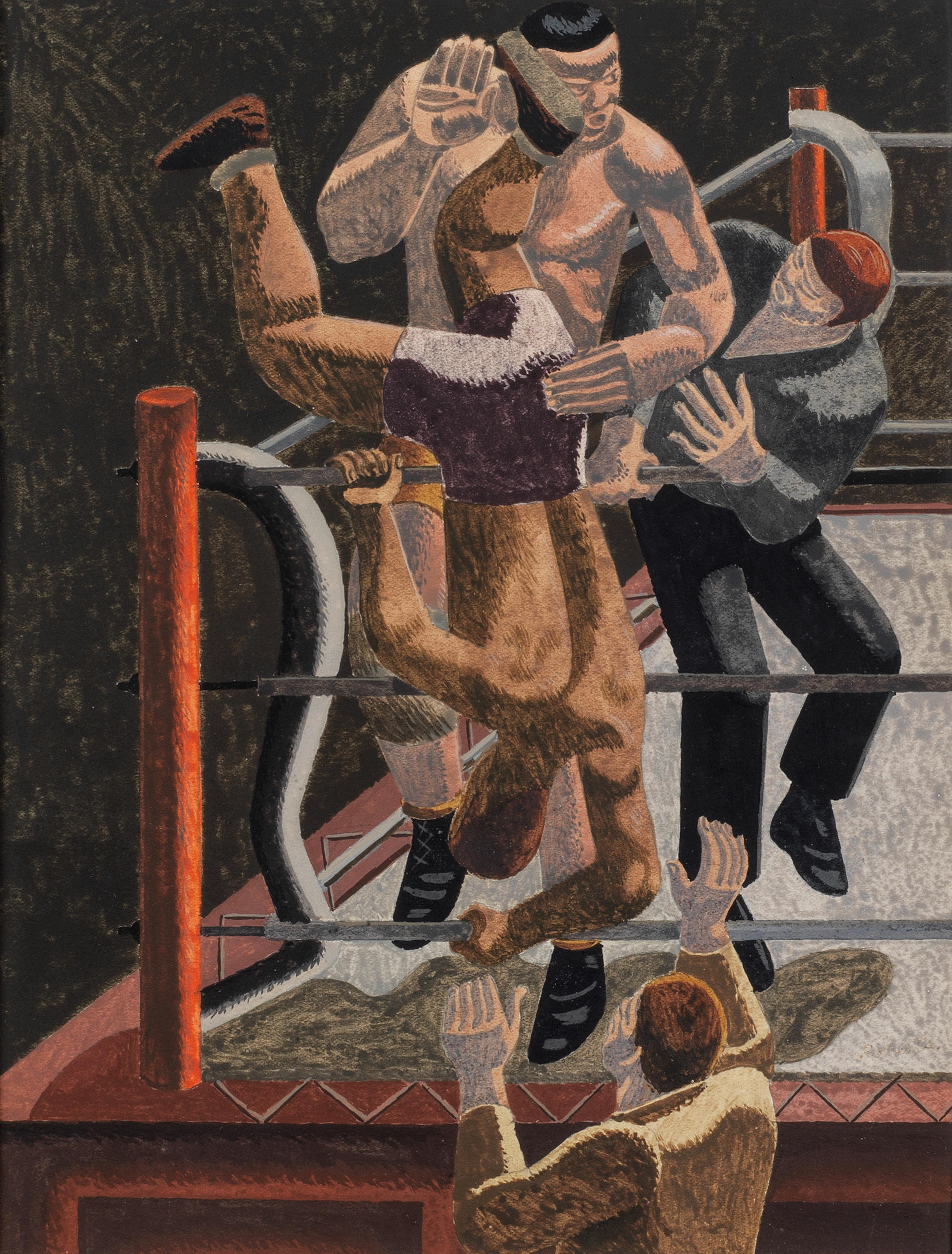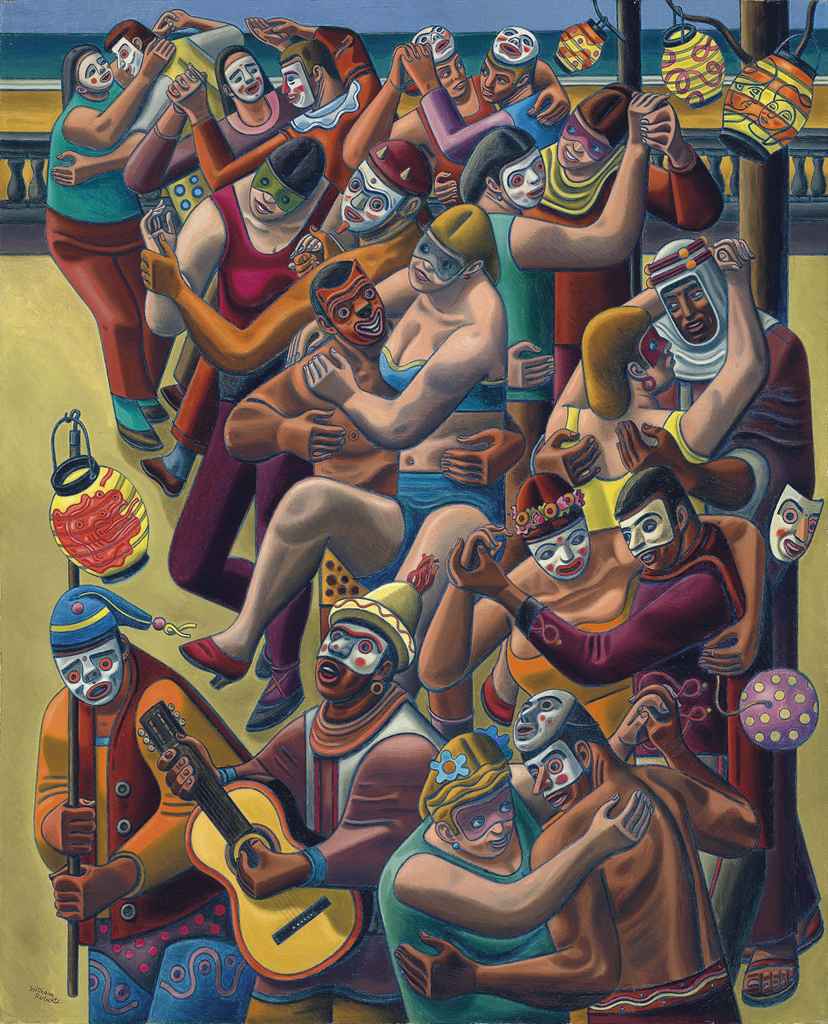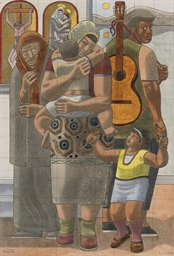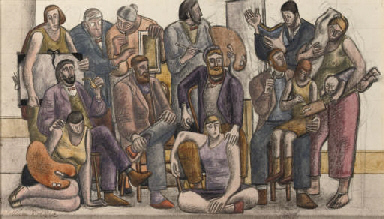William Roberts R.A. (British, 1895-1980)Parson's Pleasure (On the Lawn)
signed 'Roberts' (lower left)
oil on canvas
40.9 x 51.4 cm. (16 1/8 x 20 1/4 in.)
Painted circa 1944FootnotesProvenance
Sale; Sotheby's, London, 14 November 1984, lot 90 (as The Ferry and dated 1940)
Sale; Sotheby's, London, 14 October 1987, lot 206 (as The Ferry and dated 1940)
Sale; Sotheby's, London, 20 April 1991
Sale; Sotheby's, London 2 October 1996, lot 43, where acquired by the family of the present owner
Private Collection, U.K.
Exhibited
London, The Royal Society of British Artists, Summer Exhibition, 1948, cat.no.283
London, Royal Academy, Summer Exhibition, 31 May-24 August 1980, cat.no.21 (as Parson's Pleasure (Oxford))
Newcastle upon Tyne, Hatton Gallery, William Roberts (1895–1980), 20 March–29 May 2004, cat.no.39; this exhibition travelled to Sheffield, Graves Art Gallery, 12 June–4 September 2004
Nottingham, Djanogly Art Gallery, University of Nottingham, A Day in the Sun – Outdoor Pursuits in Art in the 1930s, 18 February–9 April 2006; this exhibition travelled to Salford Quays, The Lowry, 29 April–25 June 2006, cat.no.32
Chichester, Pallant House Gallery, William Roberts: England at Play, 20 January–20 March 2007 (unnumbered)
Chichester, Pallant House Gallery, The Mythic Method: Classicism in British Art 1920-50, 22 October 2016–19 February 2017 (unnumbered)
Literature
Andrew Heard, William Roberts 1895-1980, Hatton Gallery, University of Newcastle, Newcastle upon Tyne, 2004, p.75, cat.no.39 (col.ill.)
Andrew Gibbon Williams, William Roberts: An English Cubist, Lund Humphries, London, 2004, p.105 (col.ill.)
Timothy Wilcox, A Day in the Sun: Outdoor Pursuits in Art in the 1930s, Philip Wilson, London, 2006, p.31, fig.14, cat.no.32 (col.ill.)
'Parson's Pleasure is a remarkable picture to have emerged from wartime England' (Andrew Gibbon Williams).
The outbreak of war in September 1939 caused a great deal of upheaval for William Roberts and his family, resulting in a move from London to Oxford. However, in artistic terms the conflict brought about new subject matter that favoured his figurative style, which had spent much of the 1930s in the shadow of Abstraction, epitomised by the Unit One movement and spearheaded by Paul Nash and his contemporaries. With the exception of Bernard and Nora Meninsky, who had already moved to the university city, Roberts and his wife Sarah knew little of Oxford and its dreaming spires, visiting only on one previous occasion to see his paintings hung in an exhibition of British modern art at the Ashmolean Museum. Through contacts of the Meninsky's, the artist was able to secure a part time teaching job at the technical school and eventually find suitable lodgings in the suburb of Marston on the banks of the river Cherwell.
Despite its apparent limitations and in stark contrast to London, Marston surprised Roberts by providing a rich source of material for his art. There was a gypsy encampment close to his home and the artist brought this community to life in his 1943 canvas The Gypsy Camp (Private Collection) with children, men and women tending to their horses next to a wagon on the banks of the river. An earlier work, completed shortly after their move and titled Punting on the Cherwell (1939, Private Collection), illustrates the popular river pastime with a complex figurative arrangement of nineteen people making their way through the water. Roberts is able to aptly explore his interest within this full composition and shows a woman knitting, another playing a guitar and a couple sunbathing in swimming costumes at the front of the punt as a group of variously attired men navigate the Cherwell much to the intrigue of the swans.
Parson's Pleasure refers to a secluded area, which was used for male-only nude bathing in the Oxford University Parks. This popular spot was frequented by students and dons, including C.S. Lewis, with ladies in punts being directed to a path that skirted the area behind a high corrugated iron fence to save embarrassment. A similar area nearby for clothed female bathers was known as Dame's Delight and the location has appeared in art, poetry and prose over the years. In the title poem of his 1923 collection Parson's Pleasure, Christopher Morley describes the area as:
A greengloom sideloop of the creek,
A sodden place of twilight smell:
Clear dayshine did not often touch
That water; and a mouldy hutch
For the convenience of undressing.
An ancient, far from prepossessing,
Offered uncandid towels (eschewed by most).
There men's white bodies, nude,
Unconscious, comely, gallant, Greek,
Stretched, tingled cool, shone sleek, lived well
In the one patch where sunwarm fell.
Roberts liked to anchor his pictures and their subject matter in reality, rather than invent them as it were, which would have appeared spurious. The location of the present work provided a solid grounding for his exploration of a male nude composition in the classical manner he had developed through the 1930s. The classicism within Parson's Pleasure is overt and has been explained by Andrew Gibbon Williams who, along with considering this one of the artist's finest works, comments, 'The four male nudes in the foreground appear to be engaged in some Socratic dialogue while a similar, apparently more intimate, philosophical intercourse is enacted in the middle distance' (Andrew Gibbon Williams, William Roberts: An English Cubist, Lund Humphries, London, 2004, p.105). While these figures contemplate on the grass, three further men are seen enjoying or about to enjoy the water with one preparing to dive intently from the Cherwell's bank. In the distance two swans elegantly pass through the composition, patiently waiting to reclaim their territory and framed by an ordered grouping of heavily pollarded trees with the rolling Oxfordshire countryside in the background and reflected in the water. Of particular interest and clearly placing the scene in the modern age is the male smoking a pipe with a towel placed over his head in the immediate foreground. Indeed, there is an anecdote relating to Parson's Pleasure whereby a group of dons were out sunbathing one day as a female student passed by on a punt and promptly covered themselves. However, one member of the group chose to place a flannel over his head instead and when questioned why, responded, 'I don't know about you, gentlemen, but in Oxford, I, at least, am known by my face'.
We are grateful to David Cleall and Bob Davenport for their assistance in cataloguing this lot.
William Roberts R.A. (British, 1895-1980)Parson's Pleasure (On the Lawn)
signed 'Roberts' (lower left)
oil on canvas
40.9 x 51.4 cm. (16 1/8 x 20 1/4 in.)
Painted circa 1944FootnotesProvenance
Sale; Sotheby's, London, 14 November 1984, lot 90 (as The Ferry and dated 1940)
Sale; Sotheby's, London, 14 October 1987, lot 206 (as The Ferry and dated 1940)
Sale; Sotheby's, London, 20 April 1991
Sale; Sotheby's, London 2 October 1996, lot 43, where acquired by the family of the present owner
Private Collection, U.K.
Exhibited
London, The Royal Society of British Artists, Summer Exhibition, 1948, cat.no.283
London, Royal Academy, Summer Exhibition, 31 May-24 August 1980, cat.no.21 (as Parson's Pleasure (Oxford))
Newcastle upon Tyne, Hatton Gallery, William Roberts (1895–1980), 20 March–29 May 2004, cat.no.39; this exhibition travelled to Sheffield, Graves Art Gallery, 12 June–4 September 2004
Nottingham, Djanogly Art Gallery, University of Nottingham, A Day in the Sun – Outdoor Pursuits in Art in the 1930s, 18 February–9 April 2006; this exhibition travelled to Salford Quays, The Lowry, 29 April–25 June 2006, cat.no.32
Chichester, Pallant House Gallery, William Roberts: England at Play, 20 January–20 March 2007 (unnumbered)
Chichester, Pallant House Gallery, The Mythic Method: Classicism in British Art 1920-50, 22 October 2016–19 February 2017 (unnumbered)
Literature
Andrew Heard, William Roberts 1895-1980, Hatton Gallery, University of Newcastle, Newcastle upon Tyne, 2004, p.75, cat.no.39 (col.ill.)
Andrew Gibbon Williams, William Roberts: An English Cubist, Lund Humphries, London, 2004, p.105 (col.ill.)
Timothy Wilcox, A Day in the Sun: Outdoor Pursuits in Art in the 1930s, Philip Wilson, London, 2006, p.31, fig.14, cat.no.32 (col.ill.)
'Parson's Pleasure is a remarkable picture to have emerged from wartime England' (Andrew Gibbon Williams).
The outbreak of war in September 1939 caused a great deal of upheaval for William Roberts and his family, resulting in a move from London to Oxford. However, in artistic terms the conflict brought about new subject matter that favoured his figurative style, which had spent much of the 1930s in the shadow of Abstraction, epitomised by the Unit One movement and spearheaded by Paul Nash and his contemporaries. With the exception of Bernard and Nora Meninsky, who had already moved to the university city, Roberts and his wife Sarah knew little of Oxford and its dreaming spires, visiting only on one previous occasion to see his paintings hung in an exhibition of British modern art at the Ashmolean Museum. Through contacts of the Meninsky's, the artist was able to secure a part time teaching job at the technical school and eventually find suitable lodgings in the suburb of Marston on the banks of the river Cherwell.
Despite its apparent limitations and in stark contrast to London, Marston surprised Roberts by providing a rich source of material for his art. There was a gypsy encampment close to his home and the artist brought this community to life in his 1943 canvas The Gypsy Camp (Private Collection) with children, men and women tending to their horses next to a wagon on the banks of the river. An earlier work, completed shortly after their move and titled Punting on the Cherwell (1939, Private Collection), illustrates the popular river pastime with a complex figurative arrangement of nineteen people making their way through the water. Roberts is able to aptly explore his interest within this full composition and shows a woman knitting, another playing a guitar and a couple sunbathing in swimming costumes at the front of the punt as a group of variously attired men navigate the Cherwell much to the intrigue of the swans.
Parson's Pleasure refers to a secluded area, which was used for male-only nude bathing in the Oxford University Parks. This popular spot was frequented by students and dons, including C.S. Lewis, with ladies in punts being directed to a path that skirted the area behind a high corrugated iron fence to save embarrassment. A similar area nearby for clothed female bathers was known as Dame's Delight and the location has appeared in art, poetry and prose over the years. In the title poem of his 1923 collection Parson's Pleasure, Christopher Morley describes the area as:
A greengloom sideloop of the creek,
A sodden place of twilight smell:
Clear dayshine did not often touch
That water; and a mouldy hutch
For the convenience of undressing.
An ancient, far from prepossessing,
Offered uncandid towels (eschewed by most).
There men's white bodies, nude,
Unconscious, comely, gallant, Greek,
Stretched, tingled cool, shone sleek, lived well
In the one patch where sunwarm fell.
Roberts liked to anchor his pictures and their subject matter in reality, rather than invent them as it were, which would have appeared spurious. The location of the present work provided a solid grounding for his exploration of a male nude composition in the classical manner he had developed through the 1930s. The classicism within Parson's Pleasure is overt and has been explained by Andrew Gibbon Williams who, along with considering this one of the artist's finest works, comments, 'The four male nudes in the foreground appear to be engaged in some Socratic dialogue while a similar, apparently more intimate, philosophical intercourse is enacted in the middle distance' (Andrew Gibbon Williams, William Roberts: An English Cubist, Lund Humphries, London, 2004, p.105). While these figures contemplate on the grass, three further men are seen enjoying or about to enjoy the water with one preparing to dive intently from the Cherwell's bank. In the distance two swans elegantly pass through the composition, patiently waiting to reclaim their territory and framed by an ordered grouping of heavily pollarded trees with the rolling Oxfordshire countryside in the background and reflected in the water. Of particular interest and clearly placing the scene in the modern age is the male smoking a pipe with a towel placed over his head in the immediate foreground. Indeed, there is an anecdote relating to Parson's Pleasure whereby a group of dons were out sunbathing one day as a female student passed by on a punt and promptly covered themselves. However, one member of the group chose to place a flannel over his head instead and when questioned why, responded, 'I don't know about you, gentlemen, but in Oxford, I, at least, am known by my face'.
We are grateful to David Cleall and Bob Davenport for their assistance in cataloguing this lot.


.jpg)



.jpg)

.jpg)

.jpg)



.jpg)
Try LotSearch and its premium features for 7 days - without any costs!
Be notified automatically about new items in upcoming auctions.
Create an alert